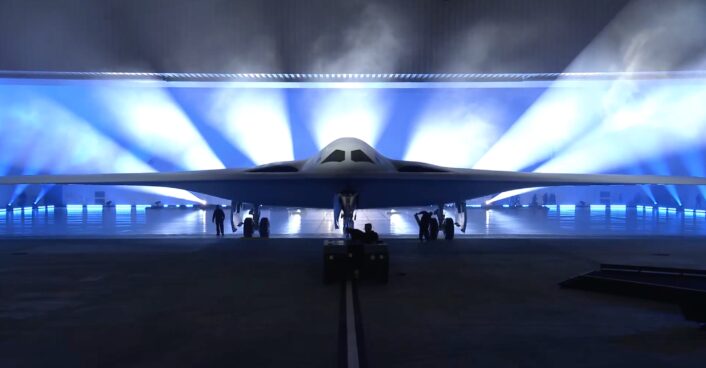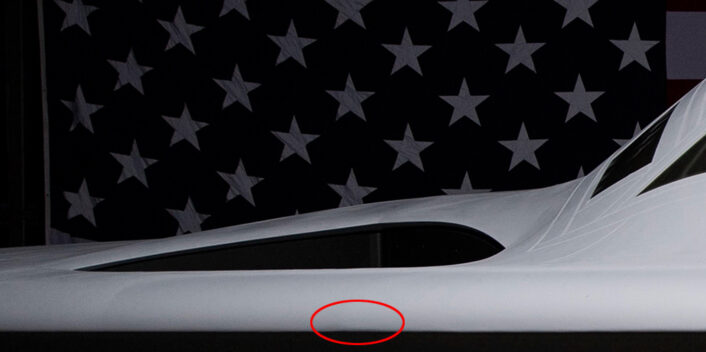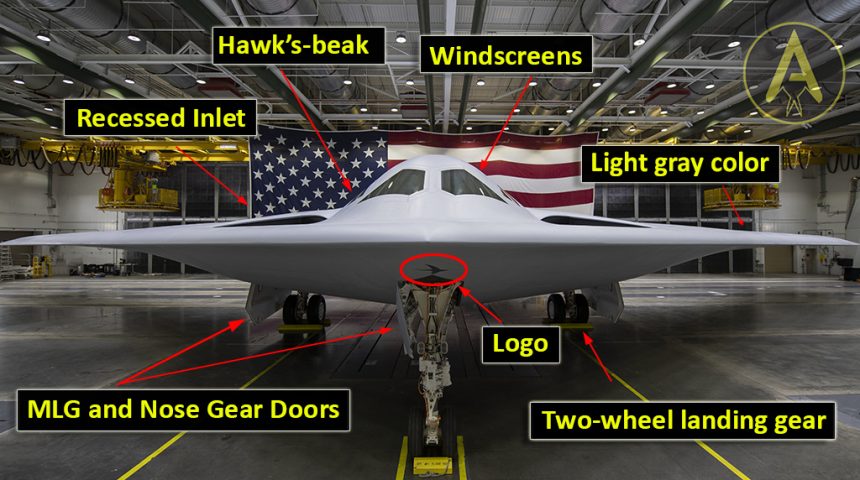Here’s our second analysis of the Northrop Grumman B-21 sixth generation stealth bomber.
It was short, sweet and stealthy. The rollout ceremony for the new Northrop Grumman B-21 Raider was a well-produced but succinct event that hinted at more than it revealed. The first major strategic bomber introduction in 34 years, the rollout ceremony at Northrop Grumman’s Palmdale, California facility featured political dignitaries, defense department officials, Air Force officers, enlisted personnel and a large group of employees responsible for the B-21 Raider program.
But the bashful star of the show was one mysterious looking gray bomber with very small engine intakes, unusual looking cockpit windows, and a wide, fat belly. There were absolutely no views of the B-21 Raider from the rear, top or side of the aircraft.

In almost every respect, the B-21 Raider rollout revealed no significant surprises from the artist renderings of the aircraft that have been in the public domain for years. As most analysts predicted, the majority of new capabilities for the B-21 Raider reside deeply concealed under its rumored-to-be new low observable coatings, within the millions (billions?) of lines of code that run its systems and a suite of sensors and network-enabled electronic and weapons capabilities that would be more at home in a science fiction novel than a current day aircraft. Given the immense operational security that has surrounded the B-21 program, it’s likely the first adversary to learn about the true operational capabilities of the Raider Raider will never survive to talk about them.
Northrop CEO Kathy Warden told Breaking Defense reporter Valerie Insinna that, “The real differences are inside of the platform, because you can think about how much digital technology has progressed since the time we built the B-2 and the time we built the B-21.”
The official unveiling of the B-21 Raider began after remarks by Secretary of Defense Lloyd Austin III, Chairman, CEO and President of Northrop Grumman Kathy Warden and Vice Chairman of the Joint Chiefs of Staff, Admiral Christopher W. Grady.
It was Secretary of Defense Lloyd Austin III who delivered the most inspiring remarks about this historic moment in aviation history. Secretary Austin III invoked the legacy of the Doolittle Raiders, the group of U.S. Army Air Corps crews who executed the famous Doolittle Raid over Japan on April 18, 1942, and the inspiration for the official name of the B-21. Austin III compared the global precision stealth-strike capabilities of the new B-21 Raider to the Doolittle Raiders’ 1942 mission when they had, “Showed the strength, and reach, of American air power”.
Austin III went on to say, “The audacity of the Doolittle Raiders has inspired generations of American Aviators. It is fitting that the next chapter in American air power is named in their honor.” And, “The B-21 Raider is the first strategic bomber in more than three decades. It is a testament to America’s enduring advantages in ingenuity and innovation.”
But despite inspiring speeches, the star of the show was the shy, gray ghost initially dressed in a sheer gossamer-fabric frock who barely poked her head out of the Palmdale hangar.
There is a subtle, and quietly sinister shift in the appearance of the B-21 Raider from its predecessor the B-2 Spirit. The B-21’s oddly formed canopy speaks to changes made from experiences with the B-2 Spirit. The B-21 is visually and dimensionally smaller than the B-2, leaving an initially less menacing impression due to its size. But the smooth, animal-like contours and strangely non-metallic appearance of its gray surface give the more sophisticated observer a sense of quiet lethality and lurking advancement that the rollout didn’t reveal and, in fact, wilfully concealed.
Here’s the updated list of the details we noticed, almost live, as the aircraft was being unveiled:
- Overall shape is similar to the one of the B-2 but the B-21 is probably smaller in size (not as small as I was expecting)
- We weren’t allowed any side or planform views. While the Raider is believed to be a flying wing like the B-2, the NG photo below and some barely visible shadows *might* mean the aircraft has a sort of cranked arrow wing similar to the one of the X-47B. This is something we’ll discover in the future.
- B-21 leading edge shows different design concept than the B-2
- We can’t completely assess the shape of the “hawk’s-beak” profile, although it seems similar to what shown in the latest rendering and less pronounced than the one of the Spirit.
- The B-21 features different inlets config (and blended conformal engine nacelles we can’t see from the front angle). The hd version of the front photo released by the U.S. Air Force reveal a splitter plate in the inlet.
- The B-21 has a two-wheel MLG (Main Landing Gear)
- MLG and Nose Gear doors: MLG doors are not trapezoidal but show serrated edges whereas the nosegear door is serrated and not attached to the gear leg but on the right side of the bay.
- The Raider has a new four-pieces windscreen, like the Spirit, but with a very different shape for the two lateral windows. The side windows appear to be arched and narrower than the ones in the front (about half the height).
- The color seems to be a light gray (like the RQ-180)
- There’s a small logo in front of the nose gear wheel bay that appears to be the stylized Northrop Grumman Flight test badge that also appears on the X-47B right wing.
— Aircraft Spots (@AircraftSpots) December 3, 2022
— JaMoBr (@jamobr_arq) December 3, 2022
Pundits and defense spending curmudgeons will almost certainly blabber on that the B-21 is not tangibly different from the 34-year old B-2 Spirit. And that will be fine with the end-user U.S. Air Force Global Strike Command. The less information that potential adversaries can divine about the B-21’s capabilities from its appearance, the better, especially when it comes to low observable technology, avionics and weapons capabilities.

The security and visual format for today’s B-21 Raider rollout ceremony was tightly controlled. This was likely in part because of a famous media faux pas 34 years ago at the November 22, 1988 rollout ceremony for the Northrop Grumman B-2 Spirit. During that ceremony, an enterprising reporter from Aviation Week & Space Technology named Mike Dornheim, along with photographer Bill Hartenstein, flew over the unveiling of the B-2 Spirit in a Cessna 172 light aircraft and took photos. This was a view of the new bomber that was deliberately obscured by its position from the official viewing location. Dornheim and Hartenstein shot photos of the new B-2 from directly overhead, revealing (at least visually) the configuration of the rear of the aircraft, including its infra-red reducing exhaust features and overall plan form.
During the first B-2 rollout in 1988, someone rented a Cessna and got the first overhead photograph of it. https://t.co/I8O3wxrIXY
— Thenewarea51 (@thenewarea51) December 3, 2022
Recall that the now famous B-2 rollout incident happened before social media. In the current media environment, if Northrop Grumman hadn’t exerted significant controls on the B-21 Raider rollout, everyone from social media influencers with Mavic drones, to cub-reporters in Cessnas and Chinese surveillance satellites would be throwing shoulders for room to get images of the B-21. This time, the airspace over Palmdale was closed by NOTAM and reserved for the flyover of the current U.S. Air Force bomber triad.
Flyovers opening the B-21 unveiling ceremony pic.twitter.com/qRSN6l6DB5
— David Cenciotti (@cencio4) December 3, 2022
But instead, the rollout of the B-21 Raider was a dignified affair, with the debutante revealing subtle external advances and hinting at profound internal operational capabilities while retaining her allure and no doubt, beginning a story that will become legend in defense and aerospace history.









